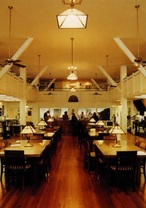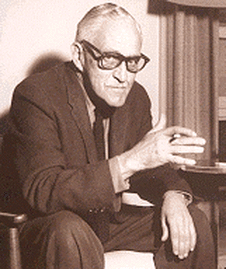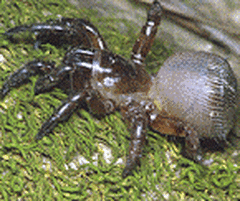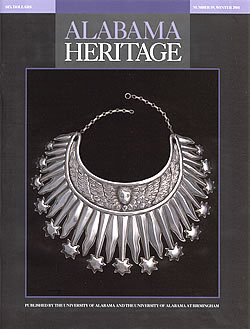|
On the cover: Inspired by the Halo of the Virgin in Mexico City's Museo de Arte Religisio, this bib necklace by William Spratling was made in the 1930s and 40s. (From the collection of Phyllis and David Goddard. Photography by John Lewis)
|
FEATURE ABSTRACTS
Good for Man or Beast: American Patent Medicines from 1865 to 1938
By Michael A. Flannery
In these days of revolutionary advances in both our medicine and in our understanding of the nature of disease, it is easy to forget that less than one hundred years ago, germ theory was in its infancy, the Food and Drug Administration was merely a glint in FDR's eye, and trips to the doctor were likely to make patients sicker than they were in the first place. On the other hand, we are also in an age when more and more people are turning to alternative medicines, so perhaps the world of patent medicines--and the motivations behind their use generations ago--is not all that difficult for us to fathom.
Additional Information
About the Author
Michael Flannery is Associate Director for Historical Collections, Lister Hill Library of the Health Sciences, University of Alabama at Birmingham. He received his M.L.S. from the University of Kentucky and his M.A. in history from California State University, Dominguez Hills. Flannery has written extensively on the history of pharmacy and pharmaco-therapeutics. His books include John Uri Lloyd: The Great American Eclectic (1998), co-authored with Alex Berman; America's Botanico-Medical Movements: Vox Populi (forthcoming, 2001), coauthored with Dennis B. Worthen; Pharmaceutical Education in the Queen City: 150 Years of the Cincinnati College of Pharmacy, 1850-2000 (forthcoming). Flannery also serves as book review editor for Pharmacy in History, the official journal of the American Institute of the History of Pharmacy. He is presently working on a history of pharmacy and drug provision during the Civil War.
The author and the editors would like to thank Dennis G. Pappas, M.D., Birmingham, for his support and encouragement in this project and for generously sharing his rich collection of patent medicines, trade cards, and artifacts.
By Michael A. Flannery
In these days of revolutionary advances in both our medicine and in our understanding of the nature of disease, it is easy to forget that less than one hundred years ago, germ theory was in its infancy, the Food and Drug Administration was merely a glint in FDR's eye, and trips to the doctor were likely to make patients sicker than they were in the first place. On the other hand, we are also in an age when more and more people are turning to alternative medicines, so perhaps the world of patent medicines--and the motivations behind their use generations ago--is not all that difficult for us to fathom.
Additional Information
- Holbrook, Stewart. The Golden Age of Quackery (Macmillan, 1959).
- McNamara, Brooks. Step Right Up, rev. ed. (University Press of Mississippi,1995).
- Silverman, Milton. Magic in a Bottle (Macmillan, 1941).
- Stage, Sarah. Female Complaints: Lydia Pinkham and the Business of Women's Medicine (W.W. Norton, 1979).
- Young, James Harvey. American Health Quackery: Collected Essays (Princeton University Press, 1992).
About the Author
Michael Flannery is Associate Director for Historical Collections, Lister Hill Library of the Health Sciences, University of Alabama at Birmingham. He received his M.L.S. from the University of Kentucky and his M.A. in history from California State University, Dominguez Hills. Flannery has written extensively on the history of pharmacy and pharmaco-therapeutics. His books include John Uri Lloyd: The Great American Eclectic (1998), co-authored with Alex Berman; America's Botanico-Medical Movements: Vox Populi (forthcoming, 2001), coauthored with Dennis B. Worthen; Pharmaceutical Education in the Queen City: 150 Years of the Cincinnati College of Pharmacy, 1850-2000 (forthcoming). Flannery also serves as book review editor for Pharmacy in History, the official journal of the American Institute of the History of Pharmacy. He is presently working on a history of pharmacy and drug provision during the Civil War.
The author and the editors would like to thank Dennis G. Pappas, M.D., Birmingham, for his support and encouragement in this project and for generously sharing his rich collection of patent medicines, trade cards, and artifacts.
 Rehabilitated c.1920 Ulmer Furniture Company building now houses the public library.
Rehabilitated c.1920 Ulmer Furniture Company building now houses the public library.
Demopolis, City of the People
By Stuart Flynn and T. J. Beitelman
Alabama's Black Belt was once awash in cotton, and every fall the planters who grew it would come to town to do business. In the Black Belt, town often meant Demopolis. Situated at the confluence of the Black Warrior and Tombigbee rivers, Demopolis has had a storied history, one that arcs and dips with that of the society and economics of the region around it, and it thrives today, thanks to a committed, unified group of people.
By Stuart Flynn and T. J. Beitelman
Alabama's Black Belt was once awash in cotton, and every fall the planters who grew it would come to town to do business. In the Black Belt, town often meant Demopolis. Situated at the confluence of the Black Warrior and Tombigbee rivers, Demopolis has had a storied history, one that arcs and dips with that of the society and economics of the region around it, and it thrives today, thanks to a committed, unified group of people.
Additional Information
The following articles in the Encyclopedia of Alabama will also be of interest:Multimedia:
About the Authors
Stuart Flynn, associate editor of Alabama Heritage, has a law degree from the University of Arkansas, and T. J. Beitelman, assistant editor of Alabama Heritage, has a master's degree in English from Virginia Tech. Both are MFA candidates in Creative Writing at the University of Alabama. Beitelman also serves as editor of The Black Warrior Review, a national literary journal published by the University of Alabama.
The authors would like to thank the following for their generous assistance with this article and their insights regarding Demopolis and the Black Belt: Gwyn Turner, T. M. Culpepper, Will Moore, Sr., Ouida Kane, Bryan Whitfield Compton, Kirk Brooker, and Demopolis mayor Austin Caldwell.
The following articles in the Encyclopedia of Alabama will also be of interest:Multimedia:
About the Authors
Stuart Flynn, associate editor of Alabama Heritage, has a law degree from the University of Arkansas, and T. J. Beitelman, assistant editor of Alabama Heritage, has a master's degree in English from Virginia Tech. Both are MFA candidates in Creative Writing at the University of Alabama. Beitelman also serves as editor of The Black Warrior Review, a national literary journal published by the University of Alabama.
The authors would like to thank the following for their generous assistance with this article and their insights regarding Demopolis and the Black Belt: Gwyn Turner, T. M. Culpepper, Will Moore, Sr., Ouida Kane, Bryan Whitfield Compton, Kirk Brooker, and Demopolis mayor Austin Caldwell.
 William Spratling at Auburn
William Spratling at Auburn(Auburn University Archives)
William Spratling
By Wayne Greenhaw
Budd Schulberg, author of the classic novel What Makes Sammy Run? and the screenplay for On the Waterfront, described his friend William Spratling this way: "He was not only My Most Unforgettable Character, buy My Five Most Unforgettable Characters." He was getting at the multifarious talents and pursuits of a man who spent his formative years in Alabama dealing with the tragic loss of both his parents. Spratling would go on to great success in New Orleans and, ultimately, Mexico, where he single-handedly revived an ancient but struggling industry in the sleepy little village of Taxco. Wayne Greenhaw takes a closer look at the life and times of William Spratling in this issue of Alabama Heritage.
Additional Information
About the Author
Wayne Greenhaw, a graduate of the University of Alabama, is the author of fourteen books and numerous articles and short stories. His latest book, Beyond the Night: A Remembrance, was published by Black Belt Press. Greenhaw is currently working on a new novel and a play for television. A frequent traveler to Mexico, where he attended school at San Miguel de Allende, Guanajuato, in 1959, Greenhaw first discovered the Spratling legend in the late 1970s. He began meeting friend of Spratling and was invited to their homes in and around Taxco. For this article, Greenhaw interviewed numerous individuals, including former students of Don Guilliermo, whom writer and former Hollywood publicity agent Ted Wick helped the author find. The editors would like to thank Phyllis Goddard for her insight regarding Spratling jewelry. Goddard owns and operates an independent reference website designed to provide the most accurate and comprehensive information about the work of William Spratling.
By Wayne Greenhaw
Budd Schulberg, author of the classic novel What Makes Sammy Run? and the screenplay for On the Waterfront, described his friend William Spratling this way: "He was not only My Most Unforgettable Character, buy My Five Most Unforgettable Characters." He was getting at the multifarious talents and pursuits of a man who spent his formative years in Alabama dealing with the tragic loss of both his parents. Spratling would go on to great success in New Orleans and, ultimately, Mexico, where he single-handedly revived an ancient but struggling industry in the sleepy little village of Taxco. Wayne Greenhaw takes a closer look at the life and times of William Spratling in this issue of Alabama Heritage.
Additional Information
- Anderson, Elizabeth and Gerald R. Kelly. Miss Elizabeth: A Memoir (Little, Brown and Company, 1969).
- Littleton, Taylor D. The Color of Silver: William Spratling, His Life and Art (Louisiana State University Press, 2000).
- Mark, Joan. The Silver Gringo, William Spratling and Taxco (University of New Mexico Press, 2000).
- Spratling, William. File on Spratling, an Autobiography (Little, Brown and Company, 1967).
About the Author
Wayne Greenhaw, a graduate of the University of Alabama, is the author of fourteen books and numerous articles and short stories. His latest book, Beyond the Night: A Remembrance, was published by Black Belt Press. Greenhaw is currently working on a new novel and a play for television. A frequent traveler to Mexico, where he attended school at San Miguel de Allende, Guanajuato, in 1959, Greenhaw first discovered the Spratling legend in the late 1970s. He began meeting friend of Spratling and was invited to their homes in and around Taxco. For this article, Greenhaw interviewed numerous individuals, including former students of Don Guilliermo, whom writer and former Hollywood publicity agent Ted Wick helped the author find. The editors would like to thank Phyllis Goddard for her insight regarding Spratling jewelry. Goddard owns and operates an independent reference website designed to provide the most accurate and comprehensive information about the work of William Spratling.
Missing in Action: The Story of Ray Davis
By Sam Duvall
Ray Davis' story is like those of thousands of other American boys sent off to fight for democracy and freedom in the greatest war of the twentieth century. Born and raised in a small town--Fort Deposit, Alabama--he quit his job at the railroad in 1943 and volunteered to fly planes over Germany. He fought hard, he fought well, and he paid the ultimate price, going down with his plane in a ball of fire over Stotzheim, Germany just as the war was turning for good in 1944. But members of Davis' family did not know the truth behind their loved one's demise until fifty years after the fact. Sam Duvall, in this issue of Alabama Heritage, examines the anguishing process the Davis family went through to find information about their son, who was reported missing in action for over a year before the Army officially declared him dead.
Additional Information
About the Author
Sam Duvall is a political consultant and freelance writer living in Montgomery. He served as legislative liaison in Gov. Guy Hunt's administration and worked as executive assistant to Gov. Fob James in his last term, 1995-99. During that period, Duvall worked for Bobby Davis, James' chief-of-staff. Duvall developed an interest in Ray Davis' story when Bobby Davis related his discovery of records at Maxwell detailing his brother's final mission. Prior to his work in government, Duvall was a political and investigative reporter for the Montgomery Advertiser (1979-83), and the Birmingham News (1983-89).
The author would like to thank Bobby Davis for use of his brother's papers and for his careful reading of the finished article, and Air Force Historical Research Agency staffers Dennis Case and Deanna Kendrick for their assistance in locating information on the 367th Fighter Group.
By Sam Duvall
Ray Davis' story is like those of thousands of other American boys sent off to fight for democracy and freedom in the greatest war of the twentieth century. Born and raised in a small town--Fort Deposit, Alabama--he quit his job at the railroad in 1943 and volunteered to fly planes over Germany. He fought hard, he fought well, and he paid the ultimate price, going down with his plane in a ball of fire over Stotzheim, Germany just as the war was turning for good in 1944. But members of Davis' family did not know the truth behind their loved one's demise until fifty years after the fact. Sam Duvall, in this issue of Alabama Heritage, examines the anguishing process the Davis family went through to find information about their son, who was reported missing in action for over a year before the Army officially declared him dead.
Additional Information
- Air Force history: HQ AFHRA, 600 Chennault Circle, Maxwell AFB, 3611 2-6424; telephone: (334) 953-5834; e-mail; website
- Groh, Richard. The Dynamite Gang: The 367th Fighter Group in WWII (Charm Publising Co., 1983).
About the Author
Sam Duvall is a political consultant and freelance writer living in Montgomery. He served as legislative liaison in Gov. Guy Hunt's administration and worked as executive assistant to Gov. Fob James in his last term, 1995-99. During that period, Duvall worked for Bobby Davis, James' chief-of-staff. Duvall developed an interest in Ray Davis' story when Bobby Davis related his discovery of records at Maxwell detailing his brother's final mission. Prior to his work in government, Duvall was a political and investigative reporter for the Montgomery Advertiser (1979-83), and the Birmingham News (1983-89).
The author would like to thank Bobby Davis for use of his brother's papers and for his careful reading of the finished article, and Air Force Historical Research Agency staffers Dennis Case and Deanna Kendrick for their assistance in locating information on the 367th Fighter Group.
DEPARTMENT ABSTRACTS
Recollections
Boom Town
By Juanita Weems Hinton
Preparing for the growth of Bluffton, developers built The Signal Hotel in the late 1880s. The town never grew as expected, but the hotel remained open, along with the town, as long as mining continued on a small scale. Now there is nothing left of Bluffton, and nothing left of the Signal Hotel. All traces have been erased, though some day they may be discovered again.
About the Author
Juanita Weems Hinton is a retired middle-school librarian and an active member of the Etowah Historical Society. She lives in Gadsden, Alabama.
Boom Town
By Juanita Weems Hinton
Preparing for the growth of Bluffton, developers built The Signal Hotel in the late 1880s. The town never grew as expected, but the hotel remained open, along with the town, as long as mining continued on a small scale. Now there is nothing left of Bluffton, and nothing left of the Signal Hotel. All traces have been erased, though some day they may be discovered again.
About the Author
Juanita Weems Hinton is a retired middle-school librarian and an active member of the Etowah Historical Society. She lives in Gadsden, Alabama.
 Cyclocosmia truncata
Cyclocosmia truncata(W. Mike Howell)
Nature Journal
Trapdoor Spiders
By L. J. Davenport
The ravine trapdoor spider, with its prominent posterior, was discovered by Nicholas Marcellus Hentz in the 1830s. This curious spider has been elusive, and its life-habits have only come to be understood within the past hundred years.
Additional Information
The following article in the Encyclopedia of Alabama will also be of interest:
About the Author
Larry Davenport is a professor of biology at Samford University, Birmingham.
Trapdoor Spiders
By L. J. Davenport
The ravine trapdoor spider, with its prominent posterior, was discovered by Nicholas Marcellus Hentz in the 1830s. This curious spider has been elusive, and its life-habits have only come to be understood within the past hundred years.
Additional Information
The following article in the Encyclopedia of Alabama will also be of interest:
About the Author
Larry Davenport is a professor of biology at Samford University, Birmingham.
